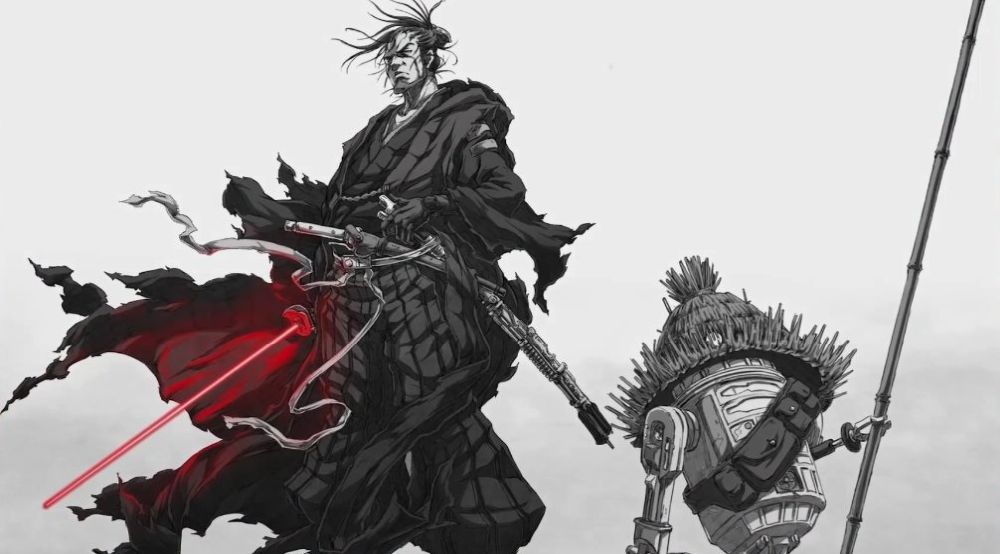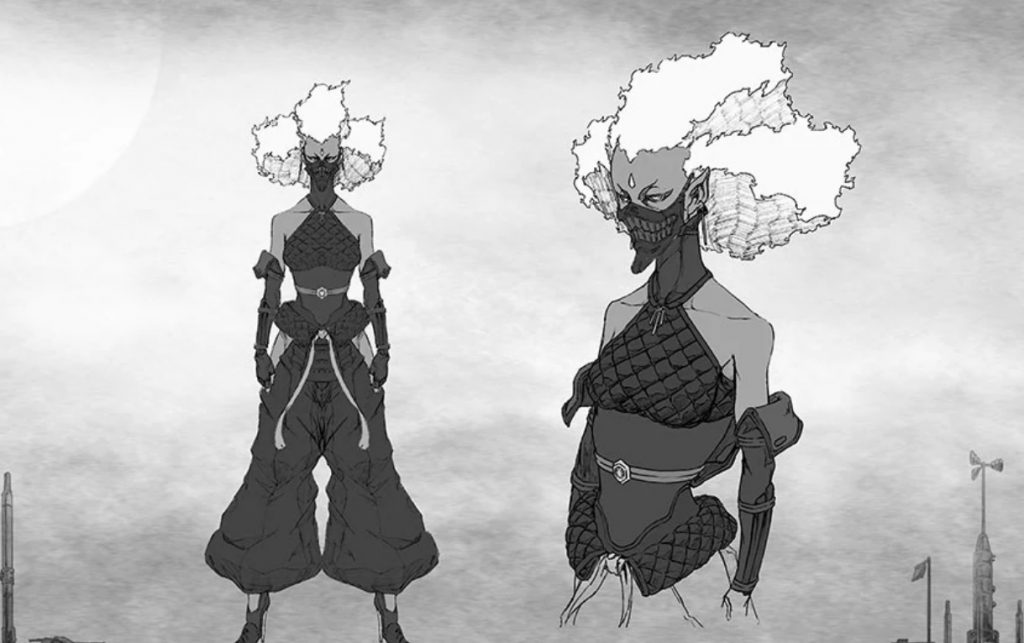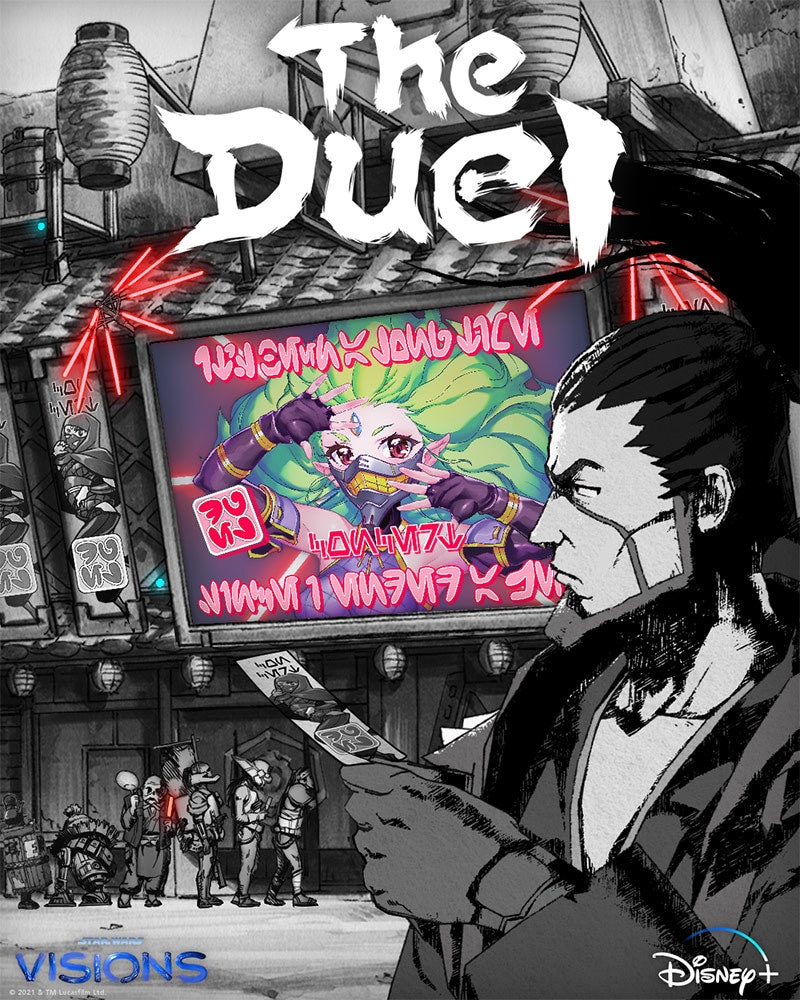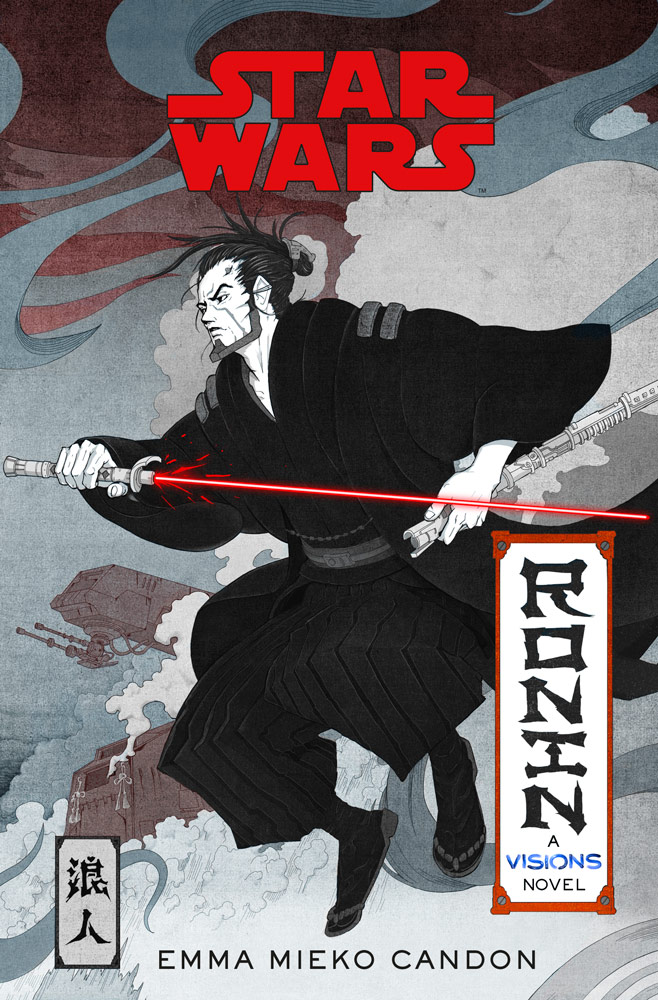The latest Star Wars novel arrives this week. Based off one of the Star Wars Visions shorts, Ronin makes for one of the best Star Wars books released.
A mysterious former Sith wanders the galaxy in this stunning Star Wars tale, an original novel inspired by the world of The Duel from the Star Wars Visions animated anthology.
The Jedi are the most loyal servants of the Empire.
Two decades ago, Jedi clans clashed in service to feuding lords. Sickened by this endless cycle, a sect of Jedi rebelled, seeking to control their own destiny and claim power in service of no master. They called themselves Sith.
The Sith rebellion failed, succumbing to infighting and betrayal, and the once rival lords unified to create an Empire . . . but even an Empire at peace is not free from violence.
Far on the edge of the Outer Rim, one former Sith wanders, accompanied only by a faithful droid and the ghost of a less civilized age. He carries a lightsaber, but claims lineage to no Jedi clan, and pledges allegiance to no lord. Little is known about him, including his name, for he never speaks of his past, nor his regrets. His history is as guarded as the red blade of destruction he carries sheathed at his side.
As the galaxy’s perpetual cycle of violence continues to interrupt his self-imposed exile, and he is forced to duel an enigmatic bandit claiming the title of Sith, it becomes clear that no amount of wandering will ever let him outpace the specters of his former life.

Review:
It’s no secret Star Wars has been unabashedly “borrowing” from Feudal Japan, Jidaigeki, and Samurai culture before anyone had even heard of a galaxy far, far away. In fact, they’ve been very anti-furtive about it, boldly waving the Akira Kurosawa flag loudly and proudly for all to see, and rightfully so. And if you’ve been around long enough then you have the honor of being told by each new generation of fans all about it. You’ll recognize this by its bedfellows, Joseph Campbell, Flash Gordon, et al.
So, if the precept of Star Wars is a collection of George Lucas’s biggest influences, woven together perfectly and succinctly, then it makes sense to properly embrace perhaps its most influential brand in an honest and forthright way, without being condescending or performative. With Star Wars Visions in many ways being the company’s exhibitionistic knee bending to the medium and culture they love, then Ronin by Emma Mieko Candon is its transcendental work of inextinguishable objet d’art. What does all that flowery language mean? Basically, if Visions is the sizzle, then Ronin is the steak.
As it stands, Star Wars Visions: Ronin sits somewhere between on the nose and perspicuous but not only is that okay, it’s also entirely the point. Is the premise contrived? Of course, it is. It’s supposed to be. The concept of even greenlighting Ronin is purposefully derivative; it’s less about realization and more just finally acknowledging the truth of what Star Wars has always been about and embracing it with your entire might. It’s a case of we know what we’re trying to say, so let’s just say it. The end result is curative in a way, like exhaling a breath you’ve been holding for a very long time, that’s the type of state I found myself in reading Ronin, sweet, sweet relief. The sensation is both metaphysical and meditative, and after you’ve read Ronin, you’ll only want “inspired by” Star Wars books going forward. And I’ve always wanted Star Wars to cut one of their hired guns loose, hand the X-34 keys over to a talented storyteller and let them have at it. We know the story group is hovering, it’s what they do, but by allowing a creative dynamo like Emma scribe a non-canon yarn not beholden to any timeline in particular is like letting a caged bird fly free for the first time. Smells like sweet, sweet freedom to me.
Okay, enough monologuing, let’s get to it, but understand this is a non-spoiler review which will seriously impede any fun I could be having writing this. But the folks at LFL have been particularly secretive about this one and I’m not interested in being a bummer.
To prepare yourself for the journey, understand that yeah, this isn’t a time and place you’ll necessarily be familiar with. You’ll be awash with not only new faces, but new ideas, concepts, factions, and most importantly of all, new (to Western chauvinistic white people) philosophies. That’s right, the dogmatism that has been with us since 1977 is getting an Eastern makeover, and it’s fucking fantastic. On paper, it seems quite practical, even reasonable to want to critically ask questions about this deity-less religion, but it’s something else entirely to stretch this rubber band to the limit without it snapping. With a parasol lightsaber in one hand and a punk aesthetic in the other, Emma does just that, with about as much skill as one could muster, and oh do they muster.

The Samurai practice Kata, which is a fundamental series of movements, and that’s what Ronin feels like. A rhythmic series of interconnected chapters orchestrated and conducted to a near perfect cadence, yes, the pacing is excellent, deliberate and finely tuned. This thing hums along much like our lead character Ronin, the strange, unassuming wanderer who at first seems to travel with little or no mandate, lacking any sense of social responsibility.
For Ronin, aka “Grim”, the dominant note is the routine, with days, weeks, even years blending together to form a series of forgettable anecdotes. If not for some particular keepsakes, or rather hunting trophies, each new day would look worryingly similar to the last. Things might live by moving, but Ronin is looking to the buck that trend and move without actually living at all. If that sounds like a man with a broken spirit, you’d be right, and as things move along, you’ll see why. But oddly enough, he’s not alone. Accompanying him through this mire he calls a life is a crafty roningasa festooned astromech droid, B5-56, and a ghost in the machine so to speak, a mysterious inner voice that loves to question his every move and speaks in riddles. Who exactly is this voice, is it the manifestation of a bad memory, or a modulating Lazarus with unfinished business? Who knows!
One’s things for certain, while he could never be accused of being loquacious, Ronin is no slouch when it comes to swinging the old stick around. Yes, the artificially jawed Kendo practitioner kicks all sorts of ass throughout the book, and much like his demeanor, does so with a quiet confidence giving you a strong sense that this is nowhere near his first time holding a lightsaber. Philosophically, he’s somewhat embraced secularism, having grown weary of the ruling Empire’s politicking and their militia, the Jedi. Yes, those peacekeeping anchorites that we know, and love, are a tad more unruly in Emma’s world; one of a handful of welcomed big changes they make.
Ethically, he barely maintains a moral code, practicing a sort of Bushido-lite where he gets choosey, only espousing a couple of the self-important tenets like Gi (justice) and Rei (respect). Listen, the man has had a falling from grace, and this brooding warrior has good reason to turn his broken heart into a sad quest, something you’ll learn as things move along, even up to and including the final passage. And this is something I want touch upon before we move on, the stat-progression nature of this story.
Front-loading, meaning big exposition dumps at the beginning of a story, generally can be found in fantasy fiction, and definitely in Western storytelling which predominantly adheres to a three-act structure. Here, Emma uses more of a traditional Japanese four-act plot where the sharing of information emerges on a need-to-know basis, a system based on relevance. This provides a more balanced approach where exposition is unhurried and metered. This affects the cast as well, as they mitigate the impact of this largish troupe by turning each one of them into assets, with basically zero throwaway characters. Of course, there’s a background populace, villages, large ships, planets, these things need people to fill up space, but as far as the dramatis personae, not a stinker in the bunch.
Speaking of which, as Emma puts the Ronin through his paces, and as formidable as he is, he gets by with a little help from his friends, both new and old. Seriously, he’d be dead a long time ago if it wasn’t for B5. And like that precocious droid, Emma surrounds their leads with a SOLID cast of supporting characters that you won’t soon forget. In fact, I’m hard pressed to think of one single character I didn’t care for, yes, from top-to-bottom, this is a very strong cast of misfits, rogues, killers, and reprobates, basically, my kind of Star Wars people.

If you’ve seen the Star Wars Visions short The Duel, then you’ve already met Kouru, the Sith Bandit leader who is hands down my favorite character in this book. Gimmicky lightsaber aside, her role in this story and relationship with the Ronin cannot be understated, and dare I say has the best arc of the bunch. She’s simply dynamite in a third act full of explosive performances and I can’t help but think she’s Emma’s favorite as well. Her presence gets to the heart of several matters, too many to mention, and too spoilery to reveal, but trust me, in a book full of tight messaging and figurative meaning, she tops them all. And like Ronin, she too has to contend with a shadow voice who stokes the flames of compulsion and revenge. Of all the tragedy that takes place in this book, her story is the melancholiest of them all in my opinion. And I know the animated short ends with her death, but it’s not a spoiler to say not only does she survive, but becomes a discernable and crucial member of the main cast.
As I mentioned earlier, Ronin can’t do what needs to be done alone and there are others who need his particular brand of skills, not to mention, very little happens in this story for no reason at all, and that includes relationships. One of these not-so-accidental meetings is with perhaps the most consequential character next to Ronin, The Traveler, or “Fox” as they are sometimes referred to. Ronin runs into them on the way to a village very early on in the book and much to his extreme frustration, the Traveler is the most inscrutable of the lot. Their banter, back-and-forth, and exchanges are some of the book’s best dialogue and provides some occasional much needed levity. They are the classic #enigmawrappedinariddle and their past, as it reveals itself, is VITAL to the book’s outcome and its connection to a certain character will induce a page break. But the balance they provided to the story and their unlimited potential as a character is sublime.
If Fox is the balance, then Ekiya is the glue. She’s the pilot of the Poor Crow, the vessel that will take this band of merry people on their little adventure, and if there’s a Frank Grimes in the book, it’s her. For practical purposes, she’s a rogue with a tough exterior, shaped by an unfortunate and violent past, which has led her to carry a pretty good grudge against both the Jedi and the Sith. She’s just the type of person this ragtag group of disparate warriors needs to remind everyone the true victims of war. Not to be out-purposed, Ekiya has designs of her own, a promise she made a long time ago, and one, through Chaos or high-water, she intends to keep. And in one of the most satisfying turn of events in the book, she strikes up a relationship with a certain someone, and it’s everything.
Last but not least is Chie, the Aunty of the Poor Crow who is serves as both Ekiya’s co-pilot and the ships elder stateswoman. She can more than handle her own when it comes to swinging her staff around, and that includes being more than a match for poor Ronin, who is the victim of her rigid form of training on more than one occasion. She’s been around the bend more than once, has her fair share of secrets, and goes as the wind blows seemingly when it comes to choosing alliances. Like everyone else on the Poor Crow, her past has left her guarded and wary of authoritarianism but remains steadfast in her belief that people are never without their worth.

We’ve talked a lot about why this book is awesome and some of the key characters that populate it awesomeness, but it’s important we understand fundamentally what Emma has tweaked. Yes, there are some clever plot devices, things such as the Mirror of the Shinsui Temple, an incredible McGuffin that is said to give visions to the beholder, fulfilling that which anyone would desire. The mirror, in of itself, is a great literary device, where a broken mirror, and its shards, reflects a distorted view of reality. Only when it is whole again is when the mirror reflects an honest representation, or an objectionable and ubiquitous truth. And this is where Emma really leans into Force users’ relationship with, and understanding of, Kyber crystals.
Figuratively, a shard, whether it is glass or kyber, simply represents a piece of information that completes the broader picture, like say, a mirror or a Lightsaber. Kyber crystals themselves are of course a wonderful metaphor about instability and finding balance. A crystal, on its own, is just a rock; it has no stability with little or no coherence. A Force user, when building a Lightsaber, defragments all of the usable pieces, including the kyber, and turns into a coherent and harmonic structure. Again, this ballyhoo is just a fancy way of saying Emma is throwing words up on a wall, there is a great purpose here, and the symbolism is right there the page for us to see.
In the world of Ronin, which likens itself to feudal Japan, the Jedi are organized by clans, each run by a Lord who serves as their Master. These clans, while serving as muscle for the Empire, also squabble amongst themselves, trying to outmaneuver one another with the help of their Knights and Guardians. As a mainspring, Emma gives us the “great war” on the planet Rei’izu, the results of which gave us this version of the Empire, and which anchors so much of what is happening in this story, even 20 years after the fact.
This event is where some of the Jedi railed against their Lords, splintering some of the clans, thus becoming Sith. This new look at an old dog cough up one of the more powerful characters in Lord Hanrai, head of one of the clans that factors heavily into a lot of what is happening to our team. They cross paths more than once (especially Ronin and Hanrai) who share a commonality which I won’t expose here. One of the encounters happens on the planet Dekien, in what can only be described as one the best action sequences in a Star Wars book in recent memory. In fact, the entire sequence on that planet feels like Emma showing off a little bit, it’s just a damn good example of using action to push the story forward, combining attention grabbing story decisions with the inevitability of their choices. Basically, nothing goes right, everything goes bad, and the characters are left to suffer the consequences of their actions. Wonderful.
This arrangement of both the Jedi and Sith, how their houses are structured, their mandates, their loyalties, even their training regiments, are different than what we are used to. In particular, the fallout from some of the decisions made by key individuals in this story, have shaken the very foundation by which many of these dioceses operate. The Ronin for example, who has entered into self-imposed exile for the role he played in past events, denies his loyalty and/or allegiance to either side, but certainly reaps the benefits from being a part of both at one time or another.
Now, when I say this is an oversimplification, I mean it. Through fear of spoilers and revealing important plot points, I’m unable to provide any of the nuances that are required to understand the complete picture. That’s one of the many beauties of this book, the first page is just as important as the last, and don’t get me started on everything in between!

So, what’s the bottom line?
This “Inspired by…” style Star Wars story proves one thing we’ve known all along. The influence films like Seven Samurai and The Hidden Fortress had on George Lucas, absolutely found their way into the substance of this galaxy and in turn, its fan base. Yes, westerns, the hero’s journey, and sci-fi serials of the time, all played their part, but the preponderance of Kurosawa’s motif is clear and present.
It occurs to me that Emma is the perfect type of author to carry this franchise forward, at least in terms of publishing, and as long as LFL is willing to continue to think outside the canon box. And that is never truer than in the third act where Emma let’s their freak flag fly a little with some incredibly abstract sequences, even by Star Wars standards. It’s certainly nothing you’ve seen in the films or live-action series, those feel stale in comparison. No, it feels more like something at home in The Clone Wars TV series, a show that, whether you liked it or not, took big risks with its content and absolutely toiled in Avant-garde storytelling. And because Star Wars has never felt anachronistic, neither existing in nor reminding us of any particular point in history, the exact time in which Ronin occurs shouldn’t be something you concern yourself with.
Star Wars fans, whether they’re aware of it or not (they are), have been enjoying a drenched form of Eastern storytelling for many years thanks to George Lucas. Freeing your mind of western chauvinisms and prejudices will allow you to really see the beauty of what Emma is doing here, giving you a perception beyond the fireworks display. And I realize that since 2014 we’ve been told that “everything is canon”, well, it isn’t anymore, so get over it. And, notwithstanding a return to the Wild West days of the Expanded Universe, which was a mess frankly, Star Wars is the better for it.
Star Wars Visions: Ronin is out now, click HERE to order a copy!
About the Author:

Emma Mieko Candon (she/they) is a queer author and escaped academic drawn to tales of devouring ghosts, cursed linguistics, and mediocre robots. Her forthcoming work includes Star Wars Visions: Ronin (2021), a Japanese reimagining of the Star Wars mythos. As an actual cyborg whose blood has been taken for science, Emma’s grateful to be stationed at home in Hawaii, where they were born and raised as a fourth-generation Japanese settler. By day, they edit anime nonsense for Seven Seas, and by night they remain academically haunted by identity, ideology, and imperialism. At all hours of the day, they are beholden to the whims of two lopsided cats and relieved by the support of an enviably handsome wife.















